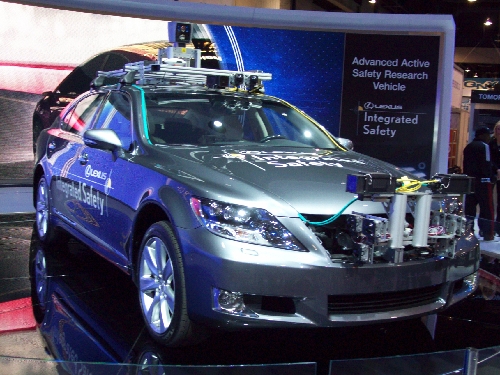International CES a trip into future
The International Consumer Electronics Show celebrated innovation on a grand scale this week. Exhibits filled 1.85 million square feet at the Las Vegas Convention Center, The Venetian, Mandalay Bay and other neighboring hotel-casinos. The 150,000 convention attendees would each need to walk about 15 miles to visit every booth on display.
Gary Shapiro, CEO of the Consumer Electronics Association, which stages the show, made a donation to the Las Vegas Convention and Visitors Authority that was accepted by authority President Rossi Ralenkotter and former Las Vegas Mayor Oscar Goodman. The money will be used to install two electric vehicle supply equipment stations at the Las Vegas Convention Center, to recharge the battery packs of electric cars owned by convention center visitors. Ralenkotter announced that the two charging stations would be combined with six more, with all eight stations installed by the time International CES returns in January 2014.
General Motors, Ford, Chrysler, Audi AG, Hyundai, Kia, Subaru, Toyota/Lexus and Tesla Motors represented the automotive electronics industry, along with supporting component vendors. Market research by the Consumer Electronics Association projects that factory sales in the automotive electronics industry will grow by 10 percent this year, increasing by $1 billion during 2013, as sales of cars and trucks rebound.
Component manufacturing companies such as Delphi and Bosch also will benefit from this surge by providing many of the subassemblies needed to create hybrid, plug-in hybrid and all-electric vehicles to comply with government-mandated corporate average fuel economy standards. These companies also will be providing "smart" electronic safety systems based on integrated cameras, ultrasonic sensors, laser-based radar and multiple types of micro electromechanical sensors.
General Motors continued to roll out plug-in electric vehicle platforms with the introduction of the Chevrolet Spark EV electric car. The 2014 Chevrolet Spark EV is a subcompact battery-powered electric car with four doors and a hatchback. A 130-horsepower electric motor can generate 400 pound feet of torque, making it fun to drive. A 20 kilowatt-hour battery pack will allow the car to travel about 60 to 80 miles before needing to be recharged. The Spark EV charging port is the first to exhibit the combined charging system that will accept electrical sources rated at AC Level 1 or Level 2 and DC Level 2 quick charge. The new DC quick charge standard allows the Chevrolet Spark EV to recharge 80 percent of its battery pack in just 20 minutes.
The Ford Motor Co. C-Max hybrid and C-Max plug-in hybrid cars were named CES 2013 Cars of the Year. Ford also displayed the Fusion Energi plug-in hybrid. Both vehicles in the Ford Energi product line can travel about 10 to 15 miles in electric-only mode before reverting to standard hybrid mode.
Audi AG displayed its R18 e-tron quattro hybrid diesel-electric racing platform that finished first and second during the 24 Hours of Le Mans in 2012, the first hybrid car to become the overall winner of this event in 80 years. The R18 e-tron quattro couples a diesel engine driving the rear two wheels of the vehicle with two electric motor/generators and a flywheel accumulator connected to the front wheels of the platform. Wicked fast!
Speaking of wicked fast, Tesla Motors displayed its new all-electric Model S sedan that was voted Motor Trend Car of the Year for 2013. The Model S was in the booth of Tesla's vendor partner Nvidia, which provided the graphics chips and software for the car's 17-inch center touch screen console.
New robotic technologies continued to amaze visitors at the automotive electronics section at CES. Toyota exhibited an autonomous Lexus LS and provided the Prius platform used by the Google self-driving car that was displayed at the MommyTech exhibit. During 2011, Nevada became the first state in America to allow autonomous vehicles on its roads and highways. Drivers can discern a self-driving car by its red Nevada license plate. State law still requires that a human operator sit in the front seat behind the steering wheel, even though the car is doing the driving.
QNX Software Systems, an independent subsidiary of Research in Motion, has been developing secure aerospace and nuclear energy software control systems for more than 35 years. The QNX CAR 2.0 automotive platform, with its embedded Neutrino real time operating system, is a proven software development ecosystem composed of an integrated stack of software programs especially written for automotive applications.
GM and Ford said they would open selected top-layer applications within their vehicle software platforms to allow third-party software developers the opportunity to create automotive apps for their growing infotainment libraries. To avoid driver distraction, most of these new apps would be operated by push buttons connected to the steering wheel and other nonvisual human interfaces. GM said the Siri voice-recognition system used by the Apple iPhone will be installed in the Chevrolet Spark EV and other future platforms.
Welcome to the 21st century driving experience!
Stan Hanel has worked in the electronics industry for more than 30 years and is a long-time member of the Electric Auto Association and the Las Vegas Electric Vehicle Association. Hanel writes and edits for EAA's "Current Events" and LVEVA's "Watts Happening" newsletters. Contact him at stanhanel@aol.com.















